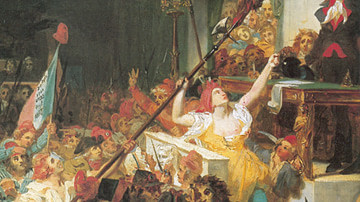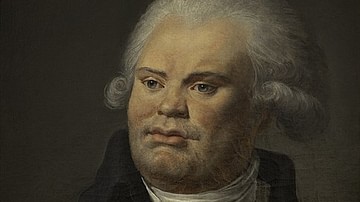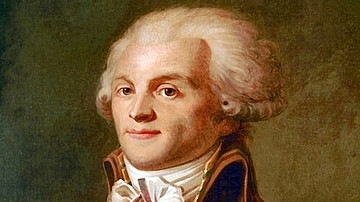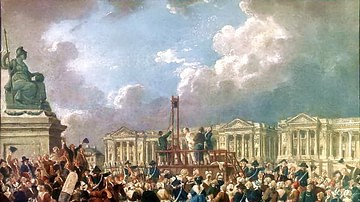
The French Revolution (1789-1799) was a period of major societal and political upheaval in France. It witnessed the collapse of the monarchy, the establishment of the First French Republic, and culminated in the rise of Napoleon Bonaparte and the start of the Napoleonic era. The French Revolution is considered one of the defining events of Western history.
The Revolution of 1789, as it is sometimes called to distinguish it from later French revolutions, originated from deep-rooted problems that the government of King Louis XVI of France (r. 1774-1792) proved incapable of fixing; such problems were primarily related to France's financial troubles as well as the systemic social inequality embedded within the Ancien Régime. The Estates-General of 1789, summoned to address these issues, resulted in the formation of a National Constituent Assembly, a body of elected representatives from the three societal orders who swore never to disband until they had written a new constitution. Over the next decade, the revolutionaries attempted to dismantle the oppressive old society and build a new one based on the principles of the Age of Enlightenment exemplified in the motto: "Liberté, égalité, fraternité."
Although initially successful in establishing a French Republic, the revolutionaries soon became embroiled in the French Revolutionary Wars (1792-1802) in which France fought against a coalition of major European powers. The Revolution quickly devolved into violent paranoia, and 20-40,000 people were killed in the Reign of Terror (1793-94), including many of the Revolution's former leaders. After the Terror, the Revolution stagnated until 1799, when Napoleon Bonaparte (1769-1821) took control of the government in the Coup of 18 Brumaire, ultimately transitioning the Republic into the First French Empire (1804-1814, 1815). Although the Revolution failed to prevent France from falling back into autocracy, it managed to succeed in other ways. It inspired numerous revolutions throughout the world and helped shape the modern concepts of nation-states, Western democracies, and human rights.
Causes
Most of the causes of the French Revolution can be traced to economic and social inequalities that were exacerbated by the brokenness of the Ancien Régime (“old regime”), the name retroactively given to the political and social system of the Kingdom of France in the last few centuries of its initial existence. The Ancien Régime was divided into three estates, or social orders: the clergy, nobility, and commoners. The first two estates enjoyed many social privileges, including tax exemptions, that were not granted to the commoners, a class that made up well over 90% of the population. The Third Estate was burdened with manual labor as well as paying most of the taxes.
Rapid population growth contributed to the general suffering; by 1789, France was the most populous European state with over 28 million people. Job growth had not kept up with the swelling population, leaving 8- 12 million impoverished. Backwards agricultural techniques and a steady string of terrible harvests led to starvation. Meanwhile, a rising class of wealthy commoners, the bourgeoisie, threatened the privileged position of the aristocracy, increasing tensions between social classes. Ideas of the Age of Enlightenment also contributed to national unrest; people began to view the Ancien Régime as corrupt, mismanaged, and tyrannical. Hatred was especially directed toward Queen Marie Antoinette, who was seen to personify everything wrong with the government.

A final significant cause was France's monumental state debt, accumulated by its attempts to maintain its status as a global power. Expensive wars and other projects had put the French treasury billions of livres into debt, as it had been forced to take out loans at enormously high interest rates. The country's irregular systems of taxation were ineffective, and as creditors began to call for repayment in the 1780s, the government finally realized something had to be done.
The Gathering Storm: 1774-1788
On 10 May 1774, King Louis XV of France died after a reign of nearly 60 years, leaving his grandson to inherit a troubled and broken kingdom. Only 19 years old, Louis XVI was an impressionable ruler who adhered to the advice of his ministers and involved France in the American War of Independence. Although French involvement in the American Revolution succeeded in weakening Great Britain, it also added substantially to France's debt while the success of the Americans encouraged anti-despotic sentiments at home.
In 1786, Louis XVI was convinced by his finance minister, Charles-Alexandre Calonne, that the issue of state debt could no longer be ignored. Calonne presented a list of financial reforms and convened the Assembly of Notables of 1787 to rubberstamp them. The Notables, a mostly aristocratic assembly, refused and told Calonne that only an Estates-General could approve such radical reforms. This referred to an assembly of the three estates of pre-revolutionary France, a body that had not been summoned in 175 years. Louis XVI refused, realizing that an Estates-General could undermine his authority. Instead, he fired Calonne and took the reforms to the parlements.
The parlements were the 13 judicial courts that were responsible for registering royal decrees before they went into effect. Consisting of aristocrats, the parlements had long struggled against royal authority, still bitter that their class had been subjugated by the "sun king" Louis XIV of France a century before. Spotting a chance to recover some power, they refused to register the royal reforms and joined the Notables in advocating for an Estates-General. When the crown responded by exiling the courts, riots erupted across the country; the parlements had presented themselves as champions of the people, thereby winning the commoners' support. One of these riots erupted in Grenoble on 7 June 1788 and led the three estates of Dauphiné to gather without the king's consent. Known as the Day of Tiles, this is credited by some historians as the start of the Revolution. Realizing he had been bested, Louis XVI appointed the popular Jacques Necker as his new finance minister and scheduled an Estates-General to convene in May 1789.
Rise of the Third Estate: February-September 1789
Across France, 6 million people participated in the electoral process for the Estates-General, and a total 25,000 cahiers de doléances, or lists of grievances, were drawn up for discussion. When the Estates-General of 1789 finally convened on 5 May in Versailles, there were 578 deputies representing the Third Estate, 282 for the nobility, and 303 for the clergy. Yet the double representation of the Third Estate was meaningless, as votes would still be counted by estate rather than by head. As the upper classes were sure to vote together, the Third Estate was at a disadvantage.
Subsequently, the Third Estate refused to verify its own elections, a process needed to begin proceedings. It demanded votes to be counted by head, a condition the nobility staunchly refused. Meanwhile, Louis XVI's attention was drawn away by the death of his son, paralyzing royal authority. On 13 June, having reached an impasse, the Third Estate commenced roll call, breaking protocol by beginning proceedings without the consent of the king or the other orders. On 17 June, following a motion proposed by Abbé Emmanuel-Joseph Sieyès, the Third Estate officially proclaimed itself a National Constituent Assembly. Two days later, the clergy formally voted to join it, and the nobility begrudgingly followed suit. On 20 June, after finding themselves locked out of the assembly hall, the deputies of the National Assembly met in the royal tennis court. There, they swore the Tennis Court Oath, promising never to disband until they had given France a new constitution. The French Revolution had begun.
Louis XVI realized he needed to regain control. In early July, he called over 30,000 soldiers into the Paris Basin, and on 11 July, he dismissed Necker and other ministers considered too friendly to the insolent revolutionaries. Fearing the king meant to crush the Revolution, the people of Paris rioted on 12 July. Their uprising climaxed on 14 July with the Storming of the Bastille, when hundreds of citizens successfully attacked the Bastille fortress to loot it for ammunition. The king backed down, sending away his soldiers and reinstating Necker. Unnerved by these events, the king's youngest brother, Comte d'Artois, fled France with an entourage of royalists on the night of 16 July; they were the first of thousands of émigrés to flee.
In the coming weeks, the French countryside broke out into scattered riots, as rumors spread of aristocratic plots to deprive citizens of their liberties. These riots resulted in mini-Bastilles as peasants raided the feudal estates of local seigneurs, forcing nobles to renounce their feudal rights. Later known as the Great Fear, this wave of panic forced the National Assembly to confront the issue of feudalism. On the night of 4 August, in a wave of patriotic fervor, the Assembly announced that the feudal regime was "entirely destroyed" and ended the privileges of the upper classes. Later that month, it accepted the Declaration of the Rights of Man and of the Citizen, a landmark human rights document that championed the general will of the people, separation of powers, and the idea that human rights were universal. These two achievements are considered the most important and longest-lasting accomplishments of the Revolution.
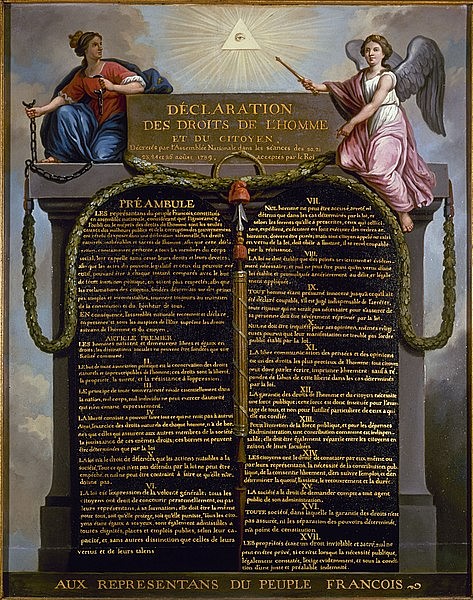
A People's Monarchy: 1789-1791
As the National Assembly slowly drafted its constitution, Louis XVI was sulking in Versailles. He refused to consent to the August Decrees and the Declaration of the Rights of Man, demanding instead that the deputies include his right to an absolute veto in the new constitution. This enraged the people of Paris, and on 5 October 1789, a crowd of 7,000 people, mostly market women, marched from Paris to Versailles in the pouring rain, demanding bread and that the king accept the Assembly's reforms. Louis XVI had no choice but to accept and was forced to leave his isolation at Versailles and accompany the women back to Paris, where he was installed in the Tuileries Palace. Known as the Women's March on Versailles, or the October Days, this insurrection led to the end of the Ancien Régime and the beginning of France's short-lived constitutional monarchy.
The next year and a half marked a relatively calm phase of the Revolution; indeed, many people believed the Revolution was over. Louis XVI agreed to adopt the Assembly's reforms and even appeared reconciled to the Revolution by accepting a tricolor cockade. The Assembly, meanwhile, began to rule France, adopting its own ill-fated currency, the assignat, to help tackle the outstanding debt. Having declawed the nobility, it now turned its attentions toward the Catholic Church. The Civil Constitution of the Clergy, issued on 12 July 1790, forced all clerics to swear oaths to the new constitution and put their loyalty to the state before their loyalty to the Pope in Rome. At the same time, church lands were confiscated by the Assembly, and the papal city of Avignon was reintegrated into France. These attacks on the church alienated many from the Revolution, including the pious Louis XVI himself.
14 July 1790, the first anniversary of the Bastille, saw a massive celebration on the Champ de Mars. Led by the Marquis de Lafayette, the Festival of the Federation was meant to mark the unity of the newly liberated French people under the magnanimous rule of their citizen-king. But the king had other plans. A year later, on the night of 20-21 June 1791, he and his family left the Tuileries in disguise and attempted to escape France in what has become known as the Flight to Varennes. They were quickly caught and returned to Paris, but their attempt had irrevocably destroyed any trust the people had in the monarchy. Calls began to mount for Louis XVI to be deposed, while some even began to seriously demand a French Republic. The issue divided the Jacobin Club, a political society where revolutionaries gathered to discuss their goals and agendas. Moderate members loyal to the idea of constitutional monarchy split to form the new Feuillant Club, while the remaining Jacobins were further radicalized.
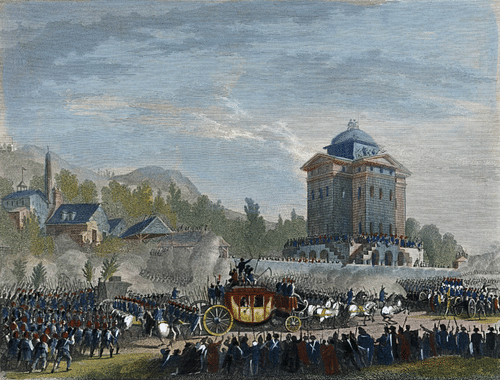
On 17 July 1791, a crowd of demonstrators gathered on the Champ de Mars to demand the king's deposition. They were fired on by the Paris National Guard, commanded by Lafayette, resulting in 50 deaths. The Champ de Mars Massacre sent republicans on the run, giving the Feuillants enough time to push through their constitution, which centered around a weakened, liberal monarchy. On 30 September 1791, the new Legislative Assembly met, but despite the long-awaited constitution, the Revolution was more divided than ever.
Birth of a Republic: 1792-1793
Many deputies of the Legislative Assembly formed themselves into two factions: the more conservative Feuillants sat on the right of the Assembly president, while the radical Jacobins sat to his left, giving rise to the left/right political spectrum still used today. After the monarchs of Austria and Prussia threatened to destroy the Revolution in the Declaration of Pillnitz, a third faction split off from the Jacobins, demanding war as the only way to preserve the Revolution. This war party, later known as the Girondins, quickly dominated the Legislative Assembly, which voted to declare war on Austria on 20 April 1792. This began the French Revolutionary Wars (1792-1802), as the old regimes of Europe, feeling threatened by the radical revolutionaries, joined together in a coalition against France.
Initially, the war went disastrously for the French. The summer of 1792 saw a Prussian army accompanied by French royalist émigrés slowly march toward Paris. In August, the invaders issued the Brunswick Manifesto, threatening to destroy Paris should any harm come to the French royal family. This threat sent the people of Paris into a hysterical panic that led to the Storming of the Tuileries Palace on 10 August 1792, the insurrection that finally toppled the monarchy. Still fearful of counter-revolutionary enemies who might aid the Prussians, Paris mobs then invaded the city's prisons and murdered over 1,100 people in the September Massacres.

On 20 September 1792, a French army finally halted the Prussian invasion at the miraculous Battle of Valmy. The next day, the jubilated Legislative Assembly officially proclaimed the French Republic. The later French Republican calendar dated itself from this moment, which was seen as the ultimate accomplishment of humankind. The Assembly was disbanded, and a National Convention was convened to draft a new constitution. One of the Convention's first tasks was to decide the fate of the deposed Louis XVI; ultimately, he was tried and guillotined on 21 January 1793, his family kept imprisoned in the Tower of the Temple until the trial and execution of Marie Antoinette that October. The trial and execution of Louis XVI shocked Europe, causing Great Britain, Spain, and the Dutch Republic to enter the coalition against France.
Reign of Terror: 1793-1794
After the decline of the Feuillants, the Girondins became the Revolution's moderate faction. In early 1793, they were opposed by a group of radical Jacobins called the Mountain, primarily led by Maximilien Robespierre, Georges Danton, and Jean-Paul Marat. The Girondins and the Mountain maintained a bitter rivalry until the fall of the Girondins on 2 June 1793, when roughly 80,000 sans-culottes, or lower-class revolutionaries, and National Guards surrounded the Tuileries Palace, demanding the arrests of leading Girondins. This was accomplished, and the Girondin leaders were later executed.
The Mountain's victory deeply divided the nation. The assassination of Marat by Charlotte Corday occurred amidst pockets of civil war that threatened to unravel the infant republic, such as the War in the Vendée and the federalist revolts. To quell this dissent and halt the advance of coalition armies, the Convention approved the creation of the Committee of Public Safety, which quickly assumed near total executive power. Through measures such as mass conscription, the Committee brutally crushed the civil wars and checked the foreign armies before turning its attention to unmasking domestic traitors and counter-revolutionary agents. The ensuing Reign of Terror, lasting from September 1793-July 1794 resulted in hundreds of thousands of arrests, 16,594 executions by guillotine, and tens of thousands of additional deaths. Aristocrats and clergymen were executed alongside former revolutionary leaders and thousands of ordinary people.
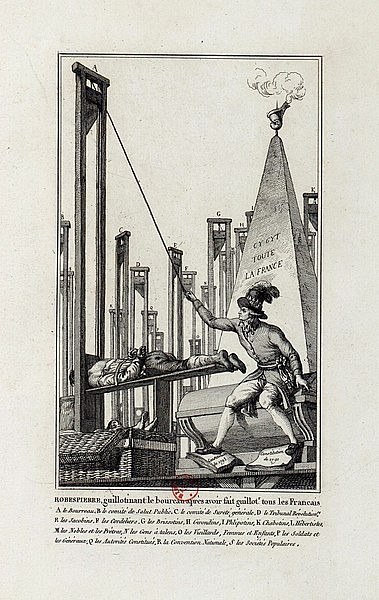
Robespierre accumulated almost dictatorial powers during this period. Attempting to curtail the Revolution's rampant dechristianization, he implemented the deistic Cult of the Supreme Being to ease France into his vision of a morally pure society. His enemies saw this as an attempt to claim total power and, fearing for their lives, decided to overthrow him; the fall of Maximilien Robespierre and his allies on 28 July 1794 brought the Terror to an end, and is considered by some historians to mark the decline of the Revolution itself.
Thermidorians & the Directory: 1794-1799
Robespierre's execution was followed by the Thermidorian Reaction, a period of conservative counter-revolution in which the vestiges of Jacobin rule were erased. The Jacobin Club itself was permanently closed in November 1794, and a Jacobin attempt to retake power in the Prairial Uprising of 1795 was crushed. The Thermidorians defeated a royalist uprising on 13 Vendémiaire (5 October 1795) before adopting the Constitution of Year III (1795) and transitioning into the French Directory, the government that led the Republic in the final years of the Revolution.
Meanwhile, French armies had succeeded in pushing back the coalition's forces, defeating most coalition nations by 1797. The star of the war was undoubtedly General Napoleon Bonaparte, whose brilliant Italian campaign of 1796-97 catapulted him to fame. On 9 November 1799, Bonaparte took control of the government in the Coup of 18 Brumaire, bringing an end to the unpopular Directory. His ascendency marked the end of the French Revolution and the beginning of the Napoleonic era.




